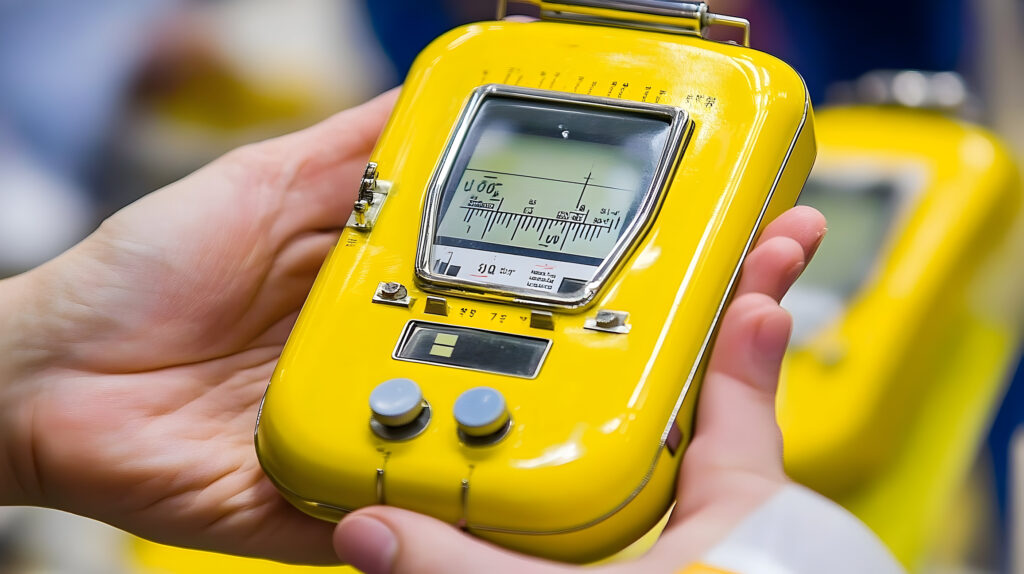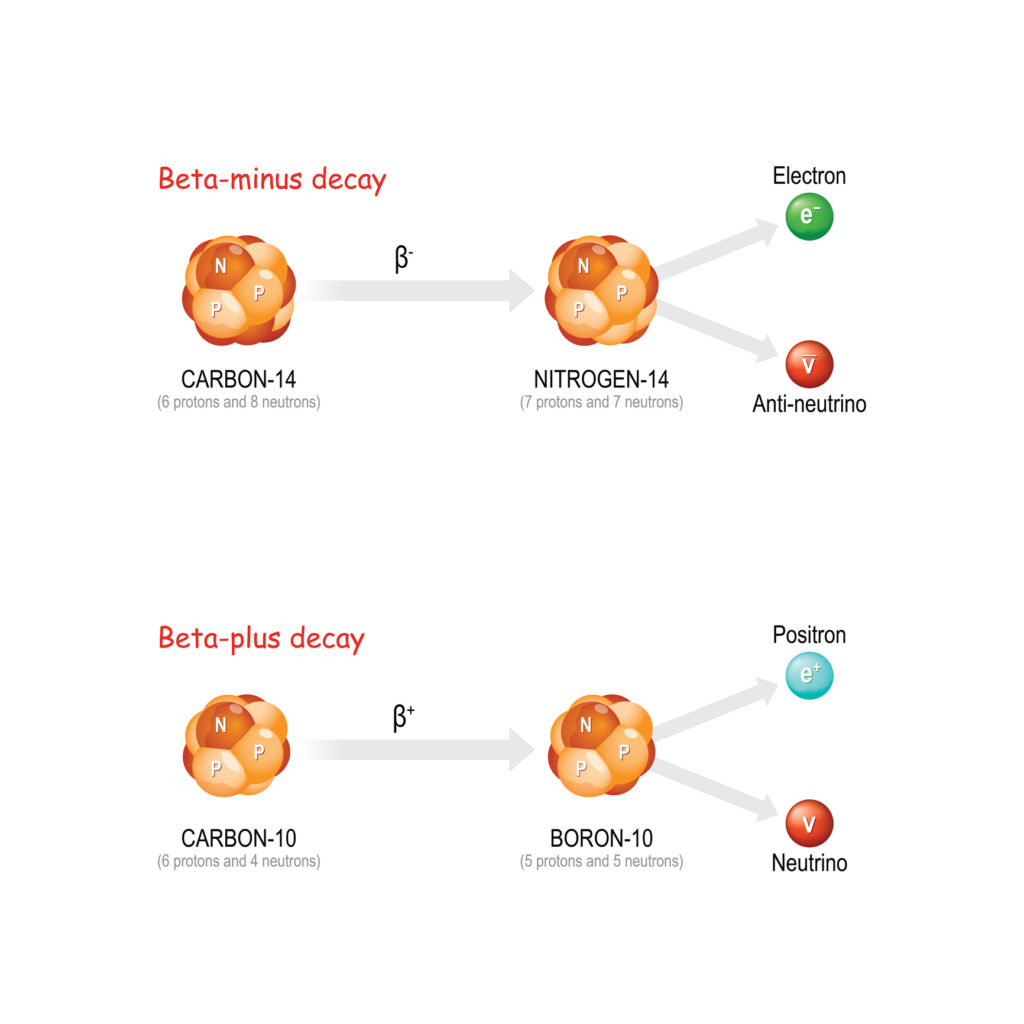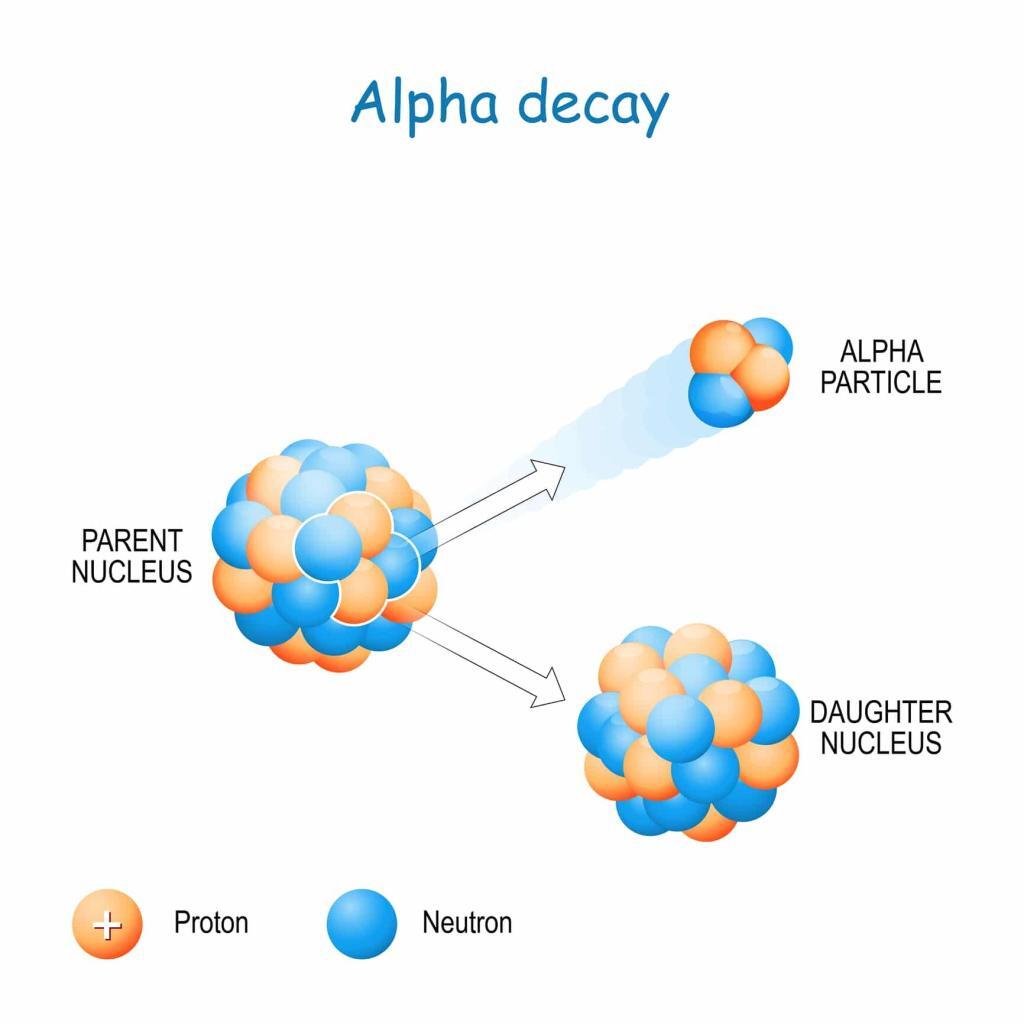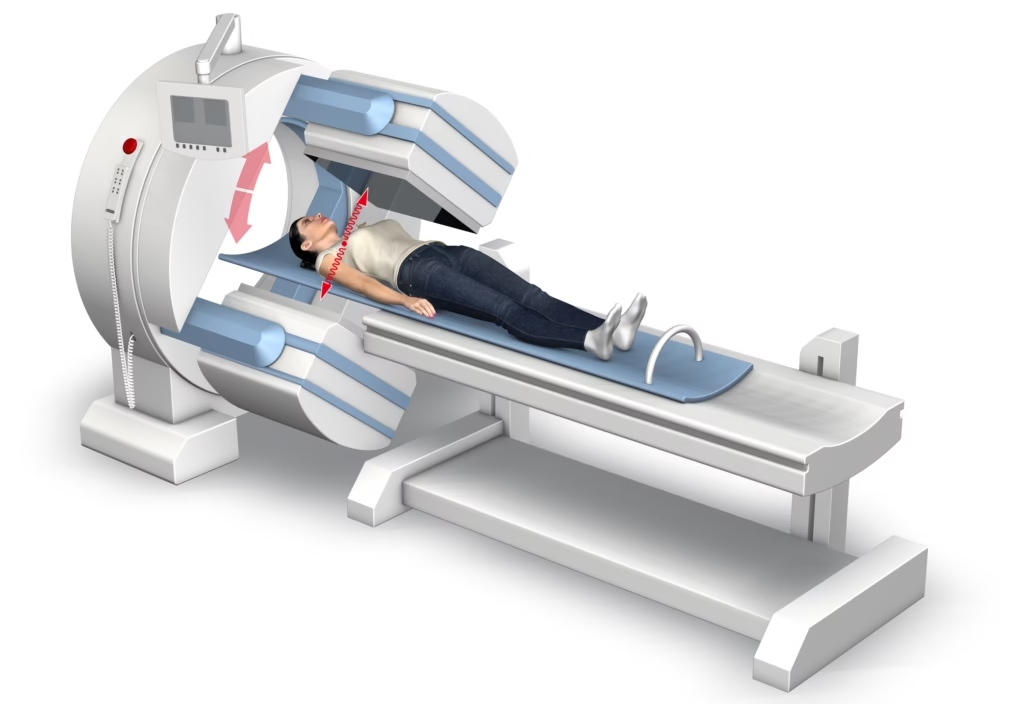Radiation safety is critical to public health and occupational safety, particularly in industries and medical practices where exposure to ionising radiation is possible. The principles of radiation safety are designed to manage and minimise exposure to radiation to prevent radiation sickness and long-term health effects such as cancer. This comprehensive discussion will explore the sources of radiation, the biological effects of radiation exposure, principles of radiation protection, regulatory standards, and practical applications of radiation safety measures.
Sources of Radiation
Radiation, a fundamental aspect of our universe, permeates through space and matter, influencing everything it encounters. Distinguished by its ability to travel in waves or particles, radiation is categorised into non-ionising and ionising types, each with distinct characteristics and implications for radiation safety.
Non-ionising radiation, encompassing visible light, microwaves, and radio waves, lacks the energy necessary to dislodge electrons from their orbits around atoms. This type of radiation is prevalent in our daily lives, emanating from sources like the sun, mobile phones, and microwave ovens. Despite its ubiquity, non-ionising radiation typically poses less direct harm to human health, primarily affecting us through thermal and photochemical actions rather than through the ionisation of atoms.
On the other hand, Ionising radiation carries enough energy to remove electrons from atoms, creating ions. This process can lead to chemical changes in matter, including living tissue, which underlies the critical importance of radiation safety. Ionising radiation is further divided into two primary sources: natural and artificial.
Natural sources of ionising radiation are as old as the universe itself. Cosmic rays, high-energy particles from outer space, constantly bombard the Earth, contributing to our background radiation exposure. These cosmic rays interact with the Earth’s atmosphere, creating secondary particles that can reach the ground and expose living organisms to radiation. Additionally, the Earth’s crust is a reservoir of radioactive materials, such as uranium, thorium, and potassium-40, which decay over time, releasing radiation. Radon gas, a radioactive decay product of uranium found in soil and rocks, can accumulate in buildings, particularly in basements and ground floors, posing health risks to occupants.
With technological advancements, artificial sources of ionising radiation have become more prevalent. Medical imaging and therapy equipment, such as X-ray machines and radiotherapy units, are significant artificial sources. These applications harness the penetrating power of ionising radiation to diagnose and treat various medical conditions, from broken bones to cancer. However, their use requires meticulous safety protocols to protect both patients and healthcare workers from unnecessary exposure.
In the industrial domain, ionising radiation plays a crucial role in myriad applications, including non-destructive testing, sterilisation of medical products, and energy generation in nuclear reactors. Industrial sources require stringent safety measures to protect workers and the environment from potential radiation hazards.
Research facilities also contribute to artificial radiation sources, utilising ionising radiation in fields ranging from physics and chemistry to biology and environmental science. These settings often involve the use of particle accelerators and nuclear reactors for experiments that probe the fundamental properties of matter or develop new technologies.
Understanding the diverse sources of radiation is paramount in developing effective radiation safety measures. By distinguishing between non-ionising and ionising radiation and acknowledging these sources’ natural and artificial origins, we can better appreciate the omnipresence of radiation in our environment and the necessity of protective strategies. These strategies are essential for minimising the risks associated with exposure to ionising radiation and for harnessing its beneficial applications safely and responsibly.
Biological Effects of Radiation Exposure
The interaction between radiation and biological systems is complex, with effects ranging from benign to severely detrimental, depending on a variety of factors. Understanding the biological effects of radiation exposure is crucial for both protecting against potential harm and harnessing radiation’s beneficial applications in fields like medicine and industry. These effects are influenced by the dose and type of radiation, the part of the body exposed, and the individual’s inherent susceptibility to radiation damage.
Radiation exposure is quantified in terms of dose, which measures the amount of energy absorbed by biological tissues. The type of radiation—whether ionising or non-ionising—plays a significant role in determining the potential for biological harm. Because of its high energy, Ionising radiation can break chemical bonds, leading to the ionisation of molecules within cells. This can cause direct damage to DNA or indirect damage through the generation of reactive oxygen species, both of which can lead to cellular dysfunction, mutations, or death.
The immediate effects of acute exposure to high doses of radiation, often referred to as radiation sickness, manifest as nausea, vomiting, fatigue, and haemorrhaging. These symptoms result from rapidly killing or damaging cells in sensitive tissues such as the gastrointestinal tract, bone marrow, and skin. The severity of radiation sickness varies with the dose of radiation received and can lead to death in extreme cases due to organ failure or infections resulting from a compromised immune system.
Long-term exposure to lower doses of radiation is more insidious, with effects that may not become apparent for years or even decades. Such exposure increases the risk of developing cancer, one of the most severe consequences of radiation. Cancer arises from mutations in the DNA that lead to uncontrolled cell division. Because ionising radiation can cause such mutations, individuals exposed to radiation over prolonged periods have a higher risk of developing cancers, particularly in tissues with rapidly dividing cells, such as the lining of the lungs (in the case of radon exposure) and the thyroid gland (especially in children exposed to radioactive iodine).
Genetic mutations, particularly those that occur in germ cells, are another significant concern, as they can be passed on to future generations, potentially leading to hereditary diseases. The susceptibility to radiation-induced genetic mutations and cancer varies among individuals, influenced by factors such as age, sex, and genetic background.
Interestingly, the body possesses mechanisms to repair DNA damage caused by low levels of radiation exposure. However, the efficiency of these repair processes is not perfect. With higher doses, the damage may be too extensive to be fixed entirely, leading to permanent changes in the DNA. This underlines the importance of dose limitation in radiation safety practices to minimise the risk of long-term biological effects.
The biological effects of radiation exposure underscore the need for a cautious approach to managing and utilising radiation. While the body has mechanisms to repair damage from low-level exposures, the potential for acute and long-term health issues necessitates strict adherence to radiation protection principles. Understanding these effects is fundamental to minimising risks, whether in medical, industrial, or everyday contexts and ensures that the benefits of using radiation are realised without compromising health and safety.
Principles of Radiation Protection
The principles of radiation protection form the cornerstone of ensuring safety in environments where exposure to ionising radiation is a possibility. Given the potential health risks associated with radiation, these principles are designed to safeguard individuals and the environment from unnecessary exposure. The framework for radiation protection is built upon three fundamental principles: justification, optimisation (ALARA), and dose limitation, each playing a crucial role in minimising the risk associated with radiation use.
Justification
The principle of justification serves as the primary gatekeeper in the decision-making process regarding the use of radiation. It mandates that any activity involving radiation exposure must yield more benefits than harm. This principle is critical in medical settings, industrial applications, and scientific research, where the use of radiation must be carefully evaluated against the potential risks involved. In healthcare, for example, the use of X-rays or CT scans is justified by their diagnostic or therapeutic value, outweighing the risk of radiation exposure to the patient. Similarly, in industrial and research contexts, the application of radiation technologies must be assessed to ensure that the benefits, such as advancements in knowledge or improvements in material properties, justify the potential risks to workers and the environment.
Optimisation (ALARA)
The principle of optimisation, often encapsulated by the acronym ALARA (As Low As Reasonably Achievable), requires that radiation exposure be kept to the minimum possible level, considering economic and social factors. This principle encourages the continuous assessment and adaptation of radiation protection measures to ensure that exposures are not only within regulatory limits but are as low as practically possible. Optimisation encompasses a wide range of strategies, including the design of facilities and equipment to reduce radiation leakage, the implementation of shielding materials, the use of personal protective equipment, and the establishment of operational protocols that limit time spent in radiation areas. By adopting an ALARA mindset, organisations and individuals can significantly reduce the risk of radiation exposure without hindering the beneficial uses of radiation.
Dose Limitation
Dose limitation is the principle that ensures the dose of radiation received by individuals does not exceed established safety limits. These limits are set by national and international regulatory bodies based on current scientific understanding of the health risks associated with radiation exposure. Dose limits are specified for different groups, including occupational exposures for workers in radiation environments, medical exposures for patients, and public exposures for the general population. By adhering to these limits, the risk of deterministic effects, such as acute radiation syndrome, and stochastic effects, such as cancer, can be minimised.
Implementing the principles of radiation protection requires a comprehensive approach that includes regulatory compliance, personnel education and training, and the application of technical measures to control exposures. Organisations and professionals working with radiation must foster a culture of safety where the principles of justification, optimisation, and dose limitation are deeply ingrained in their operational practices. This culture of safety ensures that the benefits of radiation can be realised while protecting individuals and the environment from the potential harms associated with radiation exposure.
Regulatory Standards and Guidance
The regulatory framework surrounding radiation protection is essential for safeguarding individuals and the environment from the potential adverse effects of radiation exposure. In the United Kingdom, the Health and Safety Executive (HSE) and the Environment Agency (EA) play pivotal roles in enforcing radiation protection regulations. These organisations ensure that radiation use across various medical, industrial, and research sectors adheres to strict safety standards. Internationally, the International Commission on Radiological Protection (ICRP) and the International Atomic Energy Agency (IAEA) set the benchmarks for radiation protection, offering guidance and standards that influence global practices and policies.
The ICRP, established to advance the science of radiological protection for the public benefit, focuses on providing recommendations and guidance on all aspects of radiation protection. Its recommendations serve as a foundation for national regulations around the world, guiding practices in exposure control, radiation dose limits, and risk management. The IAEA, meanwhile, works to promote the safe, secure, and peaceful use of nuclear technologies, offering standards and technical assistance to ensure that nuclear and radiation practices worldwide meet the highest safety standards.
In the UK, the regulatory framework for radiation protection is comprehensive, covering occupational exposure, public exposure, and environmental protection. This framework is based on a set of core principles that ensure the responsible use of radiation, including justification, optimisation (ALARA principle), and dose limitation. The HSE’s role involves the enforcement of these principles in workplaces, ensuring that employers and employees comply with legal requirements for radiation protection. The EA focuses on the environmental aspects, regulating radioactive substances to protect people and the environment from the harmful effects of radiation.
The regulations mandate thorough risk assessments for activities involving radiation. These assessments identify potential sources of exposure and evaluate the risks associated with routine and accidental exposures. Based on the assessment outcomes, appropriate control measures are implemented to minimise exposure and protect workers and the public. This includes the design of facilities, the use of protective equipment, and the implementation of safe work practices.
Monitoring exposure is another critical component of regulatory standards. Employers are required to monitor the radiation doses received by workers and, in some cases, the public to ensure that they do not exceed prescribed limits. This involves using personal dosimeters and environmental monitoring equipment to track exposure levels in real-time, enabling prompt action if safe limits are approached or exceeded.
Emergency preparedness is also a significant aspect of the regulatory framework, requiring organisations to have plans in place to respond effectively to radiation accidents. This includes procedures for emergency response, decontamination, medical treatment, and communication with public health authorities and the public.
Lastly, information and training are mandatory for those working with or around radiation. This ensures that all individuals understand the potential risks associated with radiation exposure and are knowledgeable about the measures they can take to protect themselves and others.
The regulatory standards and guidance for radiation protection are vital for balancing the beneficial uses of radiation in various fields against the need to protect human health and the environment. Through the diligent enforcement of these regulations and adherence to international standards, it is possible to minimise the risks associated with radiation exposure while maximising the societal benefits derived from its use.
Practical Applications of Radiation Safety Measures
Implementing radiation safety measures is a cornerstone of practices that involve ionising radiation in medical, industrial, or research settings. These measures are designed to minimise exposure and protect both workers and the public from the potential adverse effects of radiation. The practical application of radiation safety measures encompasses a multi-faceted approach, including engineering controls, administrative controls, and the use of personal protective equipment (PPE).
Engineering Controls
Engineering controls are physical modifications to the working environment or equipment that reduce or eliminate exposure to radiation. Shielding is one of the most common forms of engineering control, involving the use of materials such as lead, concrete, or water to absorb or deflect radiation, thereby reducing the dose received by individuals. For example, walls may be lined with lead in medical imaging rooms to prevent X-rays from escaping the room.
Containment involves confining radioactive materials or radiation-emitting devices to a defined area to prevent the spread of contamination. This is particularly relevant in settings where radioactive materials are used or stored, ensuring that any leaks or spills are contained within a controlled environment.
Ventilation systems, specifically designed to control airborne radioactive materials, are another crucial engineering control. These systems filter the air to remove radioactive particles, reducing workers’ inhalation risks and preventing the release of radioactive materials into the environment.
Administrative Controls
Administrative controls are policies, procedures, and practices designed to minimise radiation exposure through the management of work practices and schedules. Limiting the time individuals spend in radiation areas is a straightforward yet effective administrative control, as the dose of radiation received is directly related to the duration of exposure.
Safety procedures are essential, including protocols for handling radioactive materials and responding to radiation emergencies. These procedures ensure that all personnel know the steps to minimise exposure and manage incidents effectively.
Training is another vital administrative control, equipping workers with the knowledge and skills to work safely with radiation. Regular training sessions cover topics such as radiation safety principles, proper use of PPE, and emergency response procedures, ensuring that all personnel are competent in managing the risks associated with their work.
Personal Protective Equipment (PPE)
PPE is designed to protect individuals from radiation exposure. In medical settings, patients and healthcare workers commonly use lead aprons and thyroid shields during X-ray examinations to protect critical body parts from unnecessary exposure. Goggles and face shields may also be used to protect the eyes and face during procedures that pose a risk of contamination or exposure to radiation.
In industrial and research settings, personal dosimeters are used to monitor an individual’s radiation exposure over time, ensuring that exposure levels remain below safety limits. These devices are essential for identifying and addressing areas where additional radiation protection measures may be needed.
The practical application of radiation safety measures is integral to using radiation responsibly. By combining engineering controls, administrative controls, and PPE, it is possible to protect individuals and the environment from the potential risks of radiation exposure while still harnessing the beneficial uses of radiation in medicine, industry, and research. This balanced approach ensures that the advantages of radiation technology can be realised without compromising safety.
Conclusion
Radiation safety stands at the crossroads of technological advancement and public health, embodying the critical balance between harnessing the immense benefits of radiation and safeguarding against its potential hazards. The steadfast principles of justification, optimisation, and dose limitation underpin the journey of managing radiation exposure. These principles serve as the bedrock for developing comprehensive safety protocols that mitigate risks without stifling the innovative applications of radiation in medicine, industry, and research. Regulatory standards at national and international levels provide a structured framework for ensuring that these principles are uniformly applied, promoting a culture of safety and responsibility across all sectors that utilise radiation.
The dynamic nature of technology and scientific understanding necessitates an adaptable approach to radiation safety. As new uses for radiation emerge and existing practices evolve, the strategies for managing radiation safety must also advance. This evolution is dependent on ongoing research, continuous improvement in safety measures, and the development of more sophisticated protective equipment. The commitment to safety is a collective responsibility shared among regulators, industry professionals, healthcare providers, and researchers. Each stakeholder plays a pivotal role in maintaining the delicate balance between benefiting from the potential of radiation and protecting against its risks.
Looking forward, the challenge lies in fostering innovation while ensuring that safety remains paramount. The continuous refinement of radiation safety practices, driven by scientific advancements and regulatory oversight, will enable society to explore the full spectrum of radiation’s potential benefits. This journey of discovery and protection exemplifies our commitment to advancing human health and knowledge while steadfastly guarding against the unseen dangers of radiation. Therefore, the legacy of radiation safety is one of vigilance, innovation, and an unwavering dedication to the well-being of current and future generations.
Q & A on Radiation Safety: Balancing Benefits and Risks
Q1: What is radiation, and how is it categorised?
A1: Radiation is energy that travels in waves or particles and can interact with matter. It is commonly categorised into two main types: non-ionising radiation (e.g., visible light, microwaves, and radio waves) and ionising radiation (e.g., X-rays, gamma rays, and particles from radioactive decay).
Q2: How do non-ionising and ionising radiation differ in terms of potential harm?
A2: Non-ionising radiation generally does not carry enough energy to remove electrons from atoms, meaning it is less likely to cause direct, severe biological harm. It may have thermal or photochemical effects rather than genetic damage. Ionising radiation, however, can remove electrons and create ions, potentially causing DNA damage, mutations, and health issues like cancer if exposure is not properly managed.
Q3: What are some natural sources of ionising radiation?
A3: Natural sources include cosmic rays from outer space and radioactive elements found in the Earth’s crust, such as uranium and thorium. Radon gas, a decay product of uranium, can accumulate in buildings. These natural sources contribute to background radiation that everyone is exposed to daily.
Q4: What are some artificial sources of ionising radiation?
A4: Artificial sources include medical imaging and treatment equipment (like X-ray machines, CT scanners, and radiotherapy units), industrial applications (non-destructive testing, sterilisation of medical equipment, nuclear reactors), and research facilities (particle accelerators, laboratory-based radiation work).
Q5: How can radiation affect human health biologically?
A5: The biological effects depend on factors such as dose, exposure time, and individual susceptibility. High doses of ionising radiation can cause acute radiation sickness, with symptoms like nausea, vomiting, fatigue, and possible organ failure. Long-term exposure to lower doses increases the risk of cancer due to DNA mutations. There is also a concern about hereditary mutations passed down to future generations.
Q6: What are the fundamental principles of radiation protection?
A6: The three key principles are:
- Justification: Any use of radiation must provide net benefits that outweigh the risks.
- Optimisation (ALARA – As Low As Reasonably Achievable): Exposure should be kept to the lowest possible level, taking economic and social factors into account.
- Dose Limitation: Individuals’ exposure must not exceed regulatory dose limits to reduce the likelihood of harmful effects.
Q7: Which organisations set regulatory standards for radiation safety?
A7: In the UK, bodies such as the Health and Safety Executive (HSE) and the Environment Agency (EA) enforce radiation protection regulations. Internationally, the International Commission on Radiological Protection (ICRP) and the International Atomic Energy Agency (IAEA) provide guidelines, standards, and recommendations that influence global radiation safety practices.
Q8: How are these regulations implemented in practice?
A8: Regulations are enforced through:
- Risk assessments for activities involving radiation.
- Engineering controls like shielding and containment.
- Administrative controls such as limiting time near sources, setting safety protocols, training, and ensuring proper maintenance.
- Personal Protective Equipment (PPE), including lead aprons, thyroid shields, and personal dosimeters.
- Monitoring and record-keeping, emergency preparedness, and public communication.
Q9: Why is training and education so important in radiation safety?
A9: Proper education ensures that all personnel understand radiation risks, know how to operate equipment safely, follow protocols, and respond effectively to emergencies. Knowledge empowers both workers and the public to engage safely with environments and procedures that involve radiation.
Q10: What does the future hold for radiation safety?
A10: As new technologies emerge and scientific understanding grows, radiation safety measures will continue to evolve. Ongoing research, improved safety equipment, and enhanced regulatory standards will allow for the beneficial uses of radiation in medicine, industry, and research, while maintaining a robust commitment to public health and environmental protection.
Disclaimer
The content provided in this article, Radiation Safety: Balancing Benefits and Risks, is intended for general informational and educational purposes only. While every effort has been made to ensure the accuracy and reliability of the information at the time of publication, Open MedScience makes no representations or warranties of any kind, express or implied, about the completeness, accuracy, reliability, suitability, or availability with respect to the content.
This article does not constitute professional advice, medical guidance, legal opinion, or regulatory instruction. It should not be relied upon as a substitute for consultation with qualified health, safety, or radiation protection professionals. Any reliance placed on such information is strictly at the reader’s own risk.
Open MedScience disclaims all liability for any loss, damage, or injury arising from the use of, or reliance on, the information presented in this publication. Readers are advised to consult relevant national and international guidelines, as well as local regulatory authorities, when implementing radiation safety measures in any setting.
Regulatory requirements and best practices are subject to change and may vary depending on jurisdiction. It is the responsibility of the reader to stay informed of current laws, regulations, and standards applicable to their specific professional or institutional context.
By accessing and reading this article, you acknowledge and agree to this disclaimer in full.
You are here: home » diagnostic medical imaging blog »



